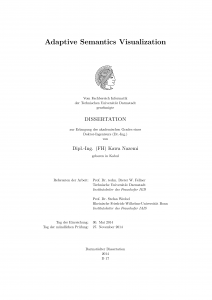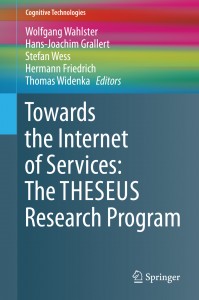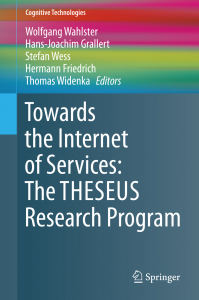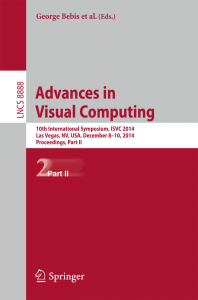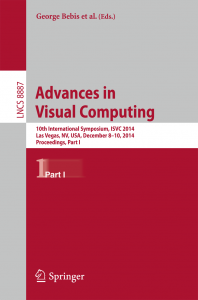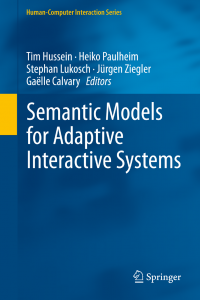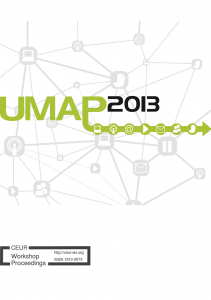Publications
Nazemi, Kawa Adaptive Semantics Visualization PhD Thesis Technische Universität Darmstadt, 2014, (Department of Computer Science. Supervised by Dieter W. Fellner.). Abstract | Links | BibTeX | Tags: Adaptive information visualization, Adaptive user interfaces, Computer based learning, Data Analytics, eGovernance, Exploratory learning, Human Factors, Human-centered user interfaces, Human-computer interaction (HCI), Information visualization, Intelligent Systems, Interaction Design, Ontology visualization, personalization, Policy modeling, Semantic data modeling, Semantic visualization, Semantic web, User behavior, User Interactions, User Interface, User modeling, User-centered design, Visual analytics Ginters, Egils; Aizstrauts, Artis; Baltruks, Mikelis; Nazemi, Kawa; Burkhardt, Dirk; Sonntagbauer, Peter; Sonntagbaur, Susanne; Gutierrez, Jorge Martin Fupol Simulators and Advanced Visualization Framework Integration Proceedings Article In: Affenzeller, Michael; Bruzzone, Agostino G.; Jimenez, Emilio; Longo, Francesco; Merkuryev, Yur; Zhang, Lin (Ed.): Proceedings of the 26th European Modeling & Simulation Symposium (EMSS 2014), pp. 523-530, I3M I3M, 2014. Abstract | Links | BibTeX | Tags: Nazemi, Kawa; Retz, Wilhelm; Kohlhammer, Jörn; Kuijper, Arjan User Similarity and Deviation Analysis for Adaptive Visualizations Proceedings Article In: Yamamoto, Sakae (Ed.): International Conference on Human Interface and the Management of Information (HMI 2014). Human Interface and the Management of Information. Information and Knowledge Design and Evaluation., pp. 64–75, Springer International Publishing , Cham, 2014, ISBN: 978-3-319-07731-7. Abstract | Links | BibTeX | Tags: Adaptive information visualization, Adaptive user interfaces, Adaptive visualization, Data Analytics, reference model, Semantic visualization, Semantics visualization, User behavior, User Interactions, User Interface, User modeling, User-centered design, Visual analytics May, Thorsten; Nazemi, Kawa; Kohlhammer, Jörn From Raw Data to Rich Visualization: Combining Visual Search with Data Analysis Book Chapter In: Wahlster, Wolfgang; Grallert, Hans-Joachim; Wess, Stefan; Friedrich, Hermann; Widenka, Thomas (Ed.): Towards the Internet of Services: The THESEUS Research Program, pp. 203–209, Springer International Publishing, Cham, 2014, ISBN: 978-3-319-06755-1. Abstract | Links | BibTeX | Tags: Visual analytics Nazemi, Kawa; Breyer, Matthias; Burkhardt, Dirk; Stab, Christian; Kohlhammer, Jörn SemaVis: A New Approach for Visualizing Semantic Information Book Chapter In: Wahlster, Wolfgang; Grallert, Hans-Joachim; Wess, Stefan; Friedrich, Hermann; Widenka, Thomas (Ed.): Towards the Internet of Services: The THESEUS Research Program, pp. 191–202, Springer International Publishing, Cham, 2014, ISBN: 978-3-319-06755-1. Abstract | Links | BibTeX | Tags: Becker, Tilman; Burghart, Catherina; Nazemi, Kawa; Ndjiki-Nya, Patrick; Riegel, Thomas; Schäfer, Ralf; Sporer, Thomas; Tresp, Volker; Wissmann, Jens Core Technologies for the Internet of Services Book Chapter In: Wahlster, Wolfgang; Grallert, Hans-Joachim; Wess, Stefan; Friedrich, Hermann; Widenka, Thomas (Ed.): Towards the Internet of Services: The THESEUS Research Program, pp. 59–88, Springer International Publishing, Cham, 2014, ISBN: 978-3-319-06755-1. Abstract | Links | BibTeX | Tags: Burkhardt, Dirk; Nazemi, Kawa; Kohlhammer, Jörn Visual Process Support to Assist Users in Policy Making Book Chapter In: Sonntagbauer, Peter; Nazemi, Kawa; Sonntagbauer, Susanne; Prister, Giorgio; Burkhardt, Dirk (Ed.): Handbook of Research on Advanced ICT Integration for Governance and Policy Modeling, pp. 149–162, IGI Global, 2014, ISBN: 978-1-466-66236-0. Abstract | Links | BibTeX | Tags: Information visualization, Interaction analysis, Process Support, Semantic visualization, Visual analytics Nazemi, Kawa; Steiger, Martin; Burkhardt, Dirk; Kohlhammer, Jörn Information Visualization and Policy Modeling Book Chapter In: Sonntagbauer, Peter; Nazemi, Kawa; Sonntagbauer, Susanne; Prister, Giorgio; Burkhardt, Dirk (Ed.): Handbook of Research on Advanced ICT Integration for Governance and Policy Modeling, pp. 175–215, Business Science Reference (IGI Global), Hershey PA, USA, Hershey PA, USA, 2014, ISBN: 978-1-466-66236-0. Abstract | Links | BibTeX | Tags: eGovernance, Information visualization, Policy modeling, Visual analytics Burkhardt, Dirk; Nazemi, Kawa; Kohlhammer, Jörn Policy modeling methodologies Book Chapter In: Sonntagbauer, Peter; Nazemi, Kawa; Sonntagbauer, Susanne; Prister, Giorgio; Burkhardt, Dirk (Ed.): Handbook of Research on Advanced ICT Integration for Governance and Policy Modeling, pp. 48–60, Business Science Reference (IGI Global), Hershey PA, USA, Hershey PA, USA, 2014, ISBN: 978-1-466-66236-0. Abstract | Links | BibTeX | Tags: eGovernance, Policy modeling Sonntagbauer, Susanne; Sonntagbauer, Peter; Nazemi, Kawa; Burkhardt, Dirk The FUPOL Policy Lifecycle Book Chapter In: Sonntagbauer, Peter; Nazemi, Kawa; Sonntagbauer, Susanne; Prister, Giorgio; Burkhardt, Dirk (Ed.): Handbook of Research on Advanced ICT Integration for Governance and Policy Modeling, Business Science Reference (IGI Global), Hershey PA, USA, Hershey PA, USA, 2014, ISBN: 978-1-466-66236-0. Abstract | Links | BibTeX | Tags: eGovernance, Policy modeling Burkhardt, Dirk; Nazemi, Kawa; Zilke, Jan Ruben; Kohlhammer, Jörn; Kuijper, Arjan Fundamental Aspects for E-Government Book Chapter In: Sonntagbauer, Peter; Nazemi, Kawa; Sonntagbauer, Susanne; Prister, Giorgio; Burkhardt, Dirk (Ed.): Handbook of Research on Advanced ICT Integration for Governance and Policy Modeling, Business Science Reference (IGI Global), Hershey PA, USA, Hershey PA, USA, 2014, ISBN: 978-1-466-66236-0. Abstract | Links | BibTeX | Tags: eGovernance, Policy modeling Nazemi, Kawa; Burkhardt, Dirk; Retz, Reimond; Kuijper, Arjan; Kohlhammer, Jörn Adaptive Visualization of Linked-Data Proceedings Article In: Bebis, George; Boyle, Richard; Parvin, Bahram; Koracin, Darko; McMahan, Ryan; Jerald, Jason; Zhang, Hui; Drucker, Steven M; Kambhamettu, Chandra; Choubassi, Maha El; Deng, Zhigang; Carlson, Mark (Ed.): Proceedings of International Symposium on Visual Computing (ISVC 2014). Advances in Visual Computing., pp. 872–883, Springer International Publishing, Cham, 2014, ISBN: 978-3-319-14364-4. Abstract | Links | BibTeX | Tags: Adaptive information visualization, Adaptive user interfaces, Adaptive visualization, Data Analytics, Human Factors, Human-centered user interfaces, Human-computer interaction (HCI), Information visualization, Intelligent Systems, Interaction analysis, Interaction Design, personalization, reference model, Semantic visualization, Semantic web, User behavior, User modeling, User-centered design, Visual analytics Burkhardt, Dirk; Nazemi, Kawa; Parisay, Mohsen; Kohlhammer, Jörn Visual Correlation Analysis to Explain Open Government Data based on Linked-Open Data for Decision Making Journal Article In: International Journal of Digital Society, vol. 5, pp. 915–923, 2014, ISSN: 2040-2570. Abstract | Links | BibTeX | Tags: Data Analytics, eGovernance, Human-computer interaction (HCI), Information visualization, Policy modeling, Visual analytics Burkhardt, Dirk; Nazemi, Kawa; Klamm, Christopher; Kohlhammer, Jörn; Kuijper, Arjan Comparison of e-Participation Roadmap in Industrial and Developing Countries Based on Germany and Kenya Proceedings Article In: Proceedings of the 8th International Conference on Theory and Practice of Electronic Governance, pp. 399–402, ACM Press, Guimaraes, Portugal, 2014, ISBN: 978-1-60558-611-3. Abstract | Links | BibTeX | Tags: digital inclusion, E-Government, E-Participation, information-communication-technologies, public participation, study Burkhardt, Dirk; Nazemi, Kawa; Retz, Wilhelm; Kohlhammer, Jörn Visual explanation of government-data for policy making through open-data inclusion Proceedings Article In: The 9th International Conference for Internet Technology and Secured Transactions (ICITST-2014), pp. 83-89, IEEE, 2014, ISBN: 978-1-908320-39-1. Abstract | Links | BibTeX | Tags: eGovernance, Human Factors, Human-centered user interfaces, Human-computer interaction (HCI), Information visualization, Interaction Design, Policy modeling, Semantic visualization, User-centered design Nazemi, Kawa; Burkhardt, Dirk; Retz, Wilhelm; Kohlhammer, Jörn Adaptive Visualization of Social Media Data for Policy Modeling Proceedings Article In: Bebis, George; Boyle, Richard; Parvin, Bahram; Koracin, Darko; McMahan, Ryan; Jerald, Jason; Zhang, Hui; Drucker, Steven M; Kambhamettu, Chandra; Choubassi, Maha El; Deng, Zhigang; Carlson, Mark (Ed.): Proceeding of the International Symposium on Visual Computing (ISVC 2014). Advances in Visual Computing., pp. 333–344, Springer International Publishing, Cham, 2014, ISBN: 978-3-319-14249-4. Abstract | Links | BibTeX | Tags: Adaptive information visualization, Adaptive user interfaces, Adaptive visualization, Data Analytics, Human Factors, Human-centered user interfaces, Human-computer interaction (HCI), Information visualization, Intelligent Systems, Interaction analysis, Interaction Design, personalization, Semantic visualization, Semantic web, User behavior, User Interactions, User Interface, User modeling, User-centered design, Visual analytics Nazemi, Kawa; Kuijper, Arjan; Hutter, Marco; Kohlhammer, Jörn; Fellner, Dieter W Measuring Context Relevance for Adaptive Semantics Visualizations Proceedings Article In: Proceedings of the 14th International Conference on Knowledge Technologies and Data-driven Business, pp. 14:1–14:8, ACM, Graz, Austria, 2014, ISBN: 978-1-4503-2769-5, (Honourable Mention). Abstract | Links | BibTeX | Tags: Adaptive information visualization, Adaptive user interfaces, Adaptive visualization, Data Analytics, data weighting, Information retrieval, semantic processing, Semantic web, Semantics visualization, User Interface, User modeling, Visual analytics Burkhardt, Dirk; Nazemi, Kawa; Encarnacao, Jose Daniel; Retz, Wilhelm; Kohlhammer, Jörn Visualization Adaptation Based on Environmental Influencing Factors Proceedings Article In: Kurosu, Masaaki (Ed.): International Conference on Human-Computer (HCI 2014). Human-Computer Interaction. Theories, Methods, and Tools., pp. 411–422, Springer International Publishing, Cham, 2014, ISBN: 978-3-319-07233-3. Abstract | Links | BibTeX | Tags: Adaptive information visualization, Adaptive user interfaces, User modeling, User-centered design, Visual analytics Stab, Christian; Burkhardt, Dirk; Breyer, Matthias; Nazemi, Kawa Visualizing Search Results of Linked Open Data Book Chapter In: Hussein, Tim; Paulheim, Heiko; Lukosch, Stephan; Ziegler, Jürgen; Calvary, Ga"elle (Ed.): Semantic Models for Adaptive Interactive Systems, pp. 133–149, Springer London, London, 2013, ISBN: 978-1-4471-5301-6. Abstract | Links | BibTeX | Tags: Human-centered user interfaces, Human-computer interaction (HCI), Linked Data, LOD, Semantic visualization, Semantic web, User behavior, User Interactions, User-centered design, Visual analytics Nazemi, Kawa; Kohlhammer, Jörn Visual Variables in Adaptive Visualizations. Proceedings Article In: Berkovsky, Shlomo; Herder, Eelco; Lops, Pasquale; Santos, Olga C. (Ed.): 21st Conference on User Modeling, Adaptation, and Personalization. UMAP 2013 Extended Proceedings. Proceeding of 1st International Workshop on User-Adaptive Visualizations., CEUR Workshop Proceedings, Rome, Italy,, 2013, ISSN: 1613-0073. Abstract | Links | BibTeX | Tags: Adaptive information visualization, Adaptive user interfaces, Adaptive visualization, Human Factors, Human-computer interaction (HCI), Information visualization, Intelligent Systems, Interaction analysis, Interaction Design, Semantic visualization2014
@phdthesis{Nazemi2014g,
title = {Adaptive Semantics Visualization},
author = {Kawa Nazemi},
url = {https://tuprints.ulb.tu-darmstadt.de/id/eprint/4319, TU Darmstadt Prints
https://tuprints.ulb.tu-darmstadt.de/4319/1/Nazemi_Diss.pdf, full text},
year = {2014},
date = {2014-11-23},
address = {Darmstadt, Germany},
school = {Technische Universität Darmstadt},
abstract = {Human access to the increasing amount of information and data plays an essential role for the professional level and also for everyday life. While information visualization has developed new and remarkable ways for visualizing data and enabling the exploration process, adaptive systems focus on users’ behavior to tailor information for supporting the information acquisition process. Recent research on adaptive visualization shows promising ways of synthesizing these two complementary approaches and make use of the surpluses of both disciplines. The emerged methods and systems aim to increase the performance, acceptance, and user experience of graphical data representations for a broad range of users. Although the evaluation results of the recently proposed systems are promising, some important aspects of information visualization are not considered in the adaptation process. The visual adaptation is commonly limited to change either visual parameters or replace visualizations entirely. Further, no existing approach adapts the visualization based on data and user characteristics. Other limitations of existing approaches include the fact that the visualizations require training by experts in the field.
In this thesis, we introduce a novel model for adaptive visualization. In contrast to existing approaches, we have focused our investigation on the potentials of information visualization for adaptation. Our reference model for visual adaptation not only considers the entire transformation, from data to visual representation, but also enhances it to meet the requirements for visual adaptation. Our model adapts different visual layers that were identified based on various models and studies on human visual perception and information processing. In its adaptation process, our conceptual model considers the impact of both data and user on visualization adaptation. We investigate different approaches and models and their effects on system adaptation to gather implicit information about users and their behavior. These are than transformed and applied to affect the visual representation and model human interaction behavior with visualizations and data to achieve a more appropriate visual adaptation. Our enhanced user model further makes use of the semantic hierarchy to enable a domain-independent adaptation.
To face the problem of a system that requires to be trained by experts, we introduce the canonical user model that models the average usage behavior with the visualization environment. Our approach learns from the behavior of the average user to adapt the different visual layers and transformation steps. This approach is further enhanced with similarity and deviation analysis for individual users to determine similar behavior on an individual level and identify differing behavior from the canonical model. Users with similar behavior get similar visualization and data recommendations, while behavioral anomalies lead to a lower level of adaptation. Our model includes a set of various visual layouts that can be used to compose a multi-visualization interface, a sort of "‘visualization cockpit"’. This model facilitates various visual layouts to provide different perspectives and enhance the ability to solve difficult and exploratory search challenges. Data from different data-sources can be visualized and compared in a visual manner. These different visual perspectives on data can be chosen by users or can be automatically selected by the system.
This thesis further introduces the implementation of our model that includes additional approaches for an efficient adaptation of visualizations as proof of feasibility. We further conduct a comprehensive user study that aims to prove the benefits of our model and underscore limitations for future work. The user study with overall 53 participants focuses with its four conditions on our enhanced reference model to evaluate the adaptation effects of the different visual layers.},
note = {Department of Computer Science. Supervised by Dieter W. Fellner.},
keywords = {Adaptive information visualization, Adaptive user interfaces, Computer based learning, Data Analytics, eGovernance, Exploratory learning, Human Factors, Human-centered user interfaces, Human-computer interaction (HCI), Information visualization, Intelligent Systems, Interaction Design, Ontology visualization, personalization, Policy modeling, Semantic data modeling, Semantic visualization, Semantic web, User behavior, User Interactions, User Interface, User modeling, User-centered design, Visual analytics},
pubstate = {published},
tppubtype = {phdthesis}
}
In this thesis, we introduce a novel model for adaptive visualization. In contrast to existing approaches, we have focused our investigation on the potentials of information visualization for adaptation. Our reference model for visual adaptation not only considers the entire transformation, from data to visual representation, but also enhances it to meet the requirements for visual adaptation. Our model adapts different visual layers that were identified based on various models and studies on human visual perception and information processing. In its adaptation process, our conceptual model considers the impact of both data and user on visualization adaptation. We investigate different approaches and models and their effects on system adaptation to gather implicit information about users and their behavior. These are than transformed and applied to affect the visual representation and model human interaction behavior with visualizations and data to achieve a more appropriate visual adaptation. Our enhanced user model further makes use of the semantic hierarchy to enable a domain-independent adaptation.
To face the problem of a system that requires to be trained by experts, we introduce the canonical user model that models the average usage behavior with the visualization environment. Our approach learns from the behavior of the average user to adapt the different visual layers and transformation steps. This approach is further enhanced with similarity and deviation analysis for individual users to determine similar behavior on an individual level and identify differing behavior from the canonical model. Users with similar behavior get similar visualization and data recommendations, while behavioral anomalies lead to a lower level of adaptation. Our model includes a set of various visual layouts that can be used to compose a multi-visualization interface, a sort of "‘visualization cockpit"’. This model facilitates various visual layouts to provide different perspectives and enhance the ability to solve difficult and exploratory search challenges. Data from different data-sources can be visualized and compared in a visual manner. These different visual perspectives on data can be chosen by users or can be automatically selected by the system.
This thesis further introduces the implementation of our model that includes additional approaches for an efficient adaptation of visualizations as proof of feasibility. We further conduct a comprehensive user study that aims to prove the benefits of our model and underscore limitations for future work. The user study with overall 53 participants focuses with its four conditions on our enhanced reference model to evaluate the adaptation effects of the different visual layers.@inproceedings{EMSS2014,
title = {Fupol Simulators and Advanced Visualization Framework Integration},
author = {Egils Ginters and Artis Aizstrauts and Mikelis Baltruks and Kawa Nazemi and Dirk Burkhardt and Peter Sonntagbauer and Susanne Sonntagbaur and Jorge Martin Gutierrez},
editor = {Michael Affenzeller and Agostino G. Bruzzone and Emilio Jimenez and Francesco Longo and Yur Merkuryev and Lin Zhang},
url = {http://www.msc-les.org/proceedings/emss/2014/EMSS2014.pdf},
year = {2014},
date = {2014-09-01},
booktitle = {Proceedings of the 26th European Modeling & Simulation Symposium (EMSS 2014)},
pages = {523-530},
publisher = {I3M},
organization = {I3M},
abstract = {FP7 FUPOL project No.287119 (see www.fupol.eu) aims at a new approach to traditional politics modeling. The FUPOL will be able to automatically collect, analyze and interpret opinions expressed on a large scale from the Internet and social networks. This will enable governments to gain a better understanding of the needs of citizens. Likewise the software will have the capabilities to simulate the effects of policies and laws and to assist governments in the whole policy design process. Basic visualization of the simulation results are supported by the simulators however visualization facilities are limited, therefore for detailed visual analysis of simulation data SemasVis environment is used.},
keywords = {},
pubstate = {published},
tppubtype = {inproceedings}
}
@inproceedings{Nazemi2014e,
title = {User Similarity and Deviation Analysis for Adaptive Visualizations},
author = {Kawa Nazemi and Wilhelm Retz and Jörn Kohlhammer and Arjan Kuijper},
editor = {Sakae Yamamoto},
url = {https://link.springer.com/chapter/10.1007/978-3-319-07731-4_7, Springer link},
doi = {10.1007/978-3-319-07731-4_7},
isbn = {978-3-319-07731-7},
year = {2014},
date = {2014-08-01},
booktitle = {International Conference on Human Interface and the Management of Information (HMI 2014). Human Interface and the Management of Information. Information and Knowledge Design and Evaluation.},
pages = {64--75},
publisher = {Springer International Publishing },
address = {Cham},
series = {LNCS 8521},
abstract = {Adaptive visualizations support users in information acquisition and exploration and therewith in human access of data. Their adaptation effect is often based on approaches that require the training by an expert. Further the effects often aims to support just the individual aptitudes. This paper introduces an approach for modeling a canonical user that makes the predefined training-files dispensable and enables an adaptation of visualizations for the majority of users. With the introduced user deviation algorithm, the behavior of individuals can be compared to the average user behavior represented in the canonical user model to identify behavioral anomalies. The further introduced similarity measurements allow to cluster similar deviated behavioral patterns as groups and provide them effective visual adaptations.},
keywords = {Adaptive information visualization, Adaptive user interfaces, Adaptive visualization, Data Analytics, reference model, Semantic visualization, Semantics visualization, User behavior, User Interactions, User Interface, User modeling, User-centered design, Visual analytics},
pubstate = {published},
tppubtype = {inproceedings}
}
@inbook{May2014,
title = {From Raw Data to Rich Visualization: Combining Visual Search with Data Analysis},
author = {Thorsten May and Kawa Nazemi and Jörn Kohlhammer},
editor = {Wolfgang Wahlster and Hans-Joachim Grallert and Stefan Wess and Hermann Friedrich and Thomas Widenka},
url = {https://www.springer.com/de/book/9783319067544?wt_mc=ThirdParty.SpringerLink.3.EPR653.About_eBook, Springer link},
doi = {10.1007/978-3-319-06755-1_16},
isbn = {978-3-319-06755-1},
year = {2014},
date = {2014-07-01},
booktitle = {Towards the Internet of Services: The THESEUS Research Program},
pages = {203--209},
publisher = {Springer International Publishing},
address = {Cham},
series = {Cognitive Technologies},
abstract = {Visual analytics is an interdisciplinary field of research at the boundary between data mining, statistics and visualization. Patterns and relations in the data complement a semantic representation of knowledge on a lower level of abstraction. One important goal of visual analytics is to find relations hidden in vast amounts of data, which can be turned into useful knowledge. Analysis needs to be ''visual'', because human's visual cognitive abilities are important for the identification and refinement of the analytical process. Further the results of the analysis have to be presented in a way to match the user's perspective on the proposed task. However, typical users are not experts in statistics or data mining. The challenge of visual analytics is to keep domain experts in charge of the analytical process while reducing the workload due to the complexity of the techniques. While search and analysis usually are mentioned in different contexts, they are highly interdependent processes. In fact, every exploratory analysis is a search for new knowledge. In turn, this knowledge can be used to refine future searches by introducing new concepts or relations to draw from. This article will show how automated and visual methods can be combined to connect knowledge artifacts on multiple levels of abstraction.},
keywords = {Visual analytics},
pubstate = {published},
tppubtype = {inbook}
}
@inbook{Nazemi2014e,
title = {SemaVis: A New Approach for Visualizing Semantic Information},
author = {Kawa Nazemi and Matthias Breyer and Dirk Burkhardt and Christian Stab and Jörn Kohlhammer},
editor = {Wolfgang Wahlster and Hans-Joachim Grallert and Stefan Wess and Hermann Friedrich and Thomas Widenka},
url = {https://link.springer.com/chapter/10.1007/978-3-319-06755-1_15, Springer link},
doi = {10.1007/978-3-319-06755-1_15},
isbn = {978-3-319-06755-1},
year = {2014},
date = {2014-07-01},
booktitle = {Towards the Internet of Services: The THESEUS Research Program},
pages = {191--202},
publisher = {Springer International Publishing},
address = {Cham},
series = {Cognitive Technologies},
abstract = {Information is an indispensable resource today. Access to and interaction with information play more and more a key role, whereas the amount of accessible information increases. Semantic technologies provide new solutions to structure this important property. One promising way to access the complex semantic structures and the huge amount of data is visualization. Today's Semantic Visualization systems offer primarily proprietary solutions for predefined and known users and usage scenarios. The adaptation to other scenarios and users is often cost- and time-consuming. This article presents a novel model for a fully adaptable and adaptive Semantics Visualization framework. Starting with the introduction of a new visualization model, the implementation of this model will be described. The article concludes with selected advantages of the described visualization technology.},
keywords = {},
pubstate = {published},
tppubtype = {inbook}
}
@inbook{Becker2014,
title = {Core Technologies for the Internet of Services},
author = {Tilman Becker and Catherina Burghart and Kawa Nazemi and Patrick Ndjiki-Nya and Thomas Riegel and Ralf Schäfer and Thomas Sporer and Volker Tresp and Jens Wissmann},
editor = {Wolfgang Wahlster and Hans-Joachim Grallert and Stefan Wess and Hermann Friedrich and Thomas Widenka},
url = {https://link.springer.com/chapter/10.1007/978-3-319-06755-1_6, Springer link},
doi = {10.1007/978-3-319-06755-1_6},
isbn = {978-3-319-06755-1},
year = {2014},
date = {2014-07-01},
booktitle = {Towards the Internet of Services: The THESEUS Research Program},
pages = {59--88},
publisher = {Springer International Publishing},
address = {Cham},
series = {Cognitive Technologies},
abstract = {Information and knowledge are growing permanently and represent valuable resources for many enterprises. The efficient access to knowledge of an enterprise like expertise, contact persons, project and milestone plans, etc. may simplify business processes and lead to time and cost savings. Semantic technologies offer numerous possibilities to enrich data with background information about their meaning. Such semantic relations do not only lead to more efficient search in larger information repositories but they also assist the user in diverse processes like editing, annotation and processing of information. In addition they offer new means of access and transfer of knowledge. Each information unit is linked to other units in the same domain, which allows faster search and offers a way of information access that is close to the habits of humans, i.e. the creation of new knowledge and its association to already existing knowledge. This approach of the whole THESEUS research program was also the basis of the Core Technology Cluster of THESEUS.},
keywords = {},
pubstate = {published},
tppubtype = {inbook}
}
@inbook{burkhardt2014visual,
title = {Visual Process Support to Assist Users in Policy Making},
author = {Dirk Burkhardt and Kawa Nazemi and Jörn Kohlhammer},
editor = {Peter Sonntagbauer and Kawa Nazemi and Susanne Sonntagbauer and Giorgio Prister and Dirk Burkhardt},
url = {https://www.igi-global.com/chapter/visual-process-support-to-assist-users-in-policy-making/116661, IGI Global},
doi = {10.4018/978-1-4666-6236-0.ch009},
isbn = {978-1-466-66236-0},
year = {2014},
date = {2014-06-01},
booktitle = {Handbook of Research on Advanced ICT Integration for Governance and Policy Modeling},
journal = {Handbook of Research on Advanced ICT Integration for Governance and Policy Modeling},
pages = {149--162},
publisher = {IGI Global},
series = {Handbook of Research},
crossref = {Sonntagbauer2014},
abstract = {The policy making process requires the involvement of various stakeholders, who bring in very heterogeneous experiences and skills concerning the policymaking domain, as well as experiences of ICT solutions. Current solutions are primarily designed to provide “one-solution-fits-all” answers, which in most cases fail the needs of all stakeholders. In this chapter, the authors introduce a new approach to assist users based on their tasks. Therefore, the system observes the interaction of the user and recognizes the current phase of the policymaking process and the profile of the user to assist him more sufficiently in solving his task. For this purpose, the system automatically enables or disables supporting features such as visualization, tools, and supporting techniques.},
keywords = {Information visualization, Interaction analysis, Process Support, Semantic visualization, Visual analytics},
pubstate = {published},
tppubtype = {inbook}
}
@inbook{nazemi2014information,
title = {Information Visualization and Policy Modeling},
author = {Kawa Nazemi and Martin Steiger and Dirk Burkhardt and Jörn Kohlhammer},
editor = {Peter Sonntagbauer and Kawa Nazemi and Susanne Sonntagbauer and Giorgio Prister and Dirk Burkhardt},
url = {https://www.igi-global.com/chapter/information-visualization-and-policy-modeling/116664, IGI Global},
doi = {10.4018/978-1-4666-6236-0.ch011},
isbn = {978-1-466-66236-0},
year = {2014},
date = {2014-06-01},
booktitle = {Handbook of Research on Advanced ICT Integration for Governance and Policy Modeling},
journal = {Handbook of Research on Advanced ICT Integration for Governance and Policy Modeling},
pages = {175--215},
publisher = {Business Science Reference (IGI Global), Hershey PA, USA},
address = {Hershey PA, USA},
series = {Handbook of Research},
crossref = {Sonntagbauer2014},
abstract = {Policy design requires the investigation of various data in several design steps for making the right decisions, validating, or monitoring the political environment. The increasing amount of data is challenging for the stakeholders in this domain. One promising way to access the “big data” is by abstracted visual patterns and pictures, as proposed by information visualization. This chapter introduces the main idea of information visualization in policy modeling. First abstracted steps of policy design are introduced that enable the identification of information visualization in the entire policy life-cycle. Thereafter, the foundations of information visualization are introduced based on an established reference model. The authors aim to amplify the incorporation of information visualization in the entire policy design process. Therefore, the aspects of data and human interaction are introduced, too. The foundation leads to description of a conceptual design for social data visualization, and the aspect of semantics plays an important role.},
keywords = {eGovernance, Information visualization, Policy modeling, Visual analytics},
pubstate = {published},
tppubtype = {inbook}
}
@inbook{burkhardt2014policy,
title = {Policy modeling methodologies},
author = {Dirk Burkhardt and Kawa Nazemi and Jörn Kohlhammer},
editor = {Peter Sonntagbauer and Kawa Nazemi and Susanne Sonntagbauer and Giorgio Prister and Dirk Burkhardt},
url = {https://www.igi-global.com/chapter/policy-modeling-methodologies/116655, IGI Global},
doi = {10.4018/978-1-4666-6236-0.ch004},
isbn = {978-1-466-66236-0},
year = {2014},
date = {2014-06-01},
booktitle = {Handbook of Research on Advanced ICT Integration for Governance and Policy Modeling},
pages = {48--60},
publisher = {Business Science Reference (IGI Global), Hershey PA, USA},
address = {Hershey PA, USA},
crossref = {Sonntagbauer2014},
abstract = {The process to develop sustainable public policies is done by public authorities ensuring the involvement of all stakeholders. ICT is rarely included in most of the today's applied policymaking processes. Other process definitions with a focus on ICT inclusion in policy modeling still exist, but they are not well defined. This chapter gives an overview of the existing policy modeling process types and explains their major foci and how they consider ICT and the practical process in public authorities. Afterwards, based on these descriptions, the general requirements on a new ICT-oriented policy modeling process that allows the inclusion of ICT into a valid and useful process for public authorities is given.},
keywords = {eGovernance, Policy modeling},
pubstate = {published},
tppubtype = {inbook}
}
@inbook{Sonntagbauer2014b,
title = {The FUPOL Policy Lifecycle},
author = {Susanne Sonntagbauer and Peter Sonntagbauer and Kawa Nazemi and Dirk Burkhardt },
editor = {Peter Sonntagbauer and Kawa Nazemi and Susanne Sonntagbauer and Giorgio Prister and Dirk Burkhardt},
url = {https://www.igi-global.com/chapter/the-fupol-policy-lifecycle/116656, IGI Global},
doi = {10.4018/978-1-4666-6236-0.ch005},
isbn = {978-1-466-66236-0},
year = {2014},
date = {2014-06-01},
booktitle = {Handbook of Research on Advanced ICT Integration for Governance and Policy Modeling},
publisher = {Business Science Reference (IGI Global), Hershey PA, USA},
address = {Hershey PA, USA},
series = {Handbook of Research},
crossref = {Sonntagbauer2014},
abstract = {The purpose of this chapter is to outline an advanced policy lifecycle, the FUPOL model with its ability to link technical features in the area of policy modeling. The FUPOL Policy Lifecycle is based on 6 stages, which are further divided into 8 main tasks. These main tasks are split up into 19 subtasks to provide a very detailed policy lifecycle structure. The detailed breakdown allows one to link each task to various technical features, such as opinion maps, policy indicator dashboard, knowledge database, and simulation and visualization tools. The chapter further argues that the methodology applied is future proof and has the potential of accommodating new technologies in the future.},
keywords = {eGovernance, Policy modeling},
pubstate = {published},
tppubtype = {inbook}
}
@inbook{Burkhardt2014e,
title = {Fundamental Aspects for E-Government},
author = {Dirk Burkhardt and Kawa Nazemi and Jan Ruben Zilke and Jörn Kohlhammer and Arjan Kuijper},
editor = {Peter Sonntagbauer and Kawa Nazemi and Susanne Sonntagbauer and Giorgio Prister and Dirk Burkhardt},
url = {https://www.igi-global.com/chapter/fundamental-aspects-for-e-government/116652, IGI Global},
doi = {10.4018/978-1-4666-6236-0.ch001},
isbn = {978-1-466-66236-0},
year = {2014},
date = {2014-06-01},
booktitle = {Handbook of Research on Advanced ICT Integration for Governance and Policy Modeling},
publisher = {Business Science Reference (IGI Global), Hershey PA, USA},
address = {Hershey PA, USA},
series = {Handbook of Research},
crossref = {Sonntagbauer2014},
abstract = {The upcoming initiatives using ICT in the government process should strengthen the benefit of e-government in most countries. Since e-government among other e-related terms is a widely (interpreted) term, it is sometimes challenging to understand the objective and goals of an initiative. Therefore, in this chapter, the authors introduce and explain most e-government related terms. Even more, they outline some interesting initiatives and implementations to explain the benefits of using ICT in the government domain. Concrete activities are aligned to the terms to explain their practical use in a better way. The authors conclude with several challenges that arise when thinking of the implementation of e-government services. Overall, this chapter should give a good overall view of e-government and the related issues.},
keywords = {eGovernance, Policy modeling},
pubstate = {published},
tppubtype = {inbook}
}
@inproceedings{Nazemi2014b,
title = {Adaptive Visualization of Linked-Data},
author = {Kawa Nazemi and Dirk Burkhardt and Reimond Retz and Arjan Kuijper and Jörn Kohlhammer},
editor = {George Bebis and Richard Boyle and Bahram Parvin and Darko Koracin and Ryan McMahan and Jason Jerald and Hui Zhang and Steven M Drucker and Chandra Kambhamettu and Maha El Choubassi and Zhigang Deng and Mark Carlson},
url = {https://link.springer.com/chapter/10.1007/978-3-319-14364-4_84, Springer link},
doi = {10.1007/978-3-319-14364-4_84},
isbn = {978-3-319-14364-4},
year = {2014},
date = {2014-03-01},
booktitle = {Proceedings of International Symposium on Visual Computing (ISVC 2014). Advances in Visual Computing.},
pages = {872--883},
publisher = {Springer International Publishing},
address = {Cham},
series = {LNCS 8888},
abstract = {Adaptive visualizations reduces the required cognitive effort to comprehend interactive visual pictures and amplify cognition. Although the research on adaptive visualizations grew in the last years, the existing approaches do not consider the transformation pipeline from data to visual representation for a more efficient and effective adaptation. Further todays systems commonly require an initial training by experts from the field and are limited to adaptation based either on user behavior or on data characteristics. A combination of both is not proposed to our knowledge. This paper introduces an enhanced instantiation of our previously proposed model that combines both: involving different influencing factors for and adapting various levels of visual peculiarities, on content, visual layout, visual presentation, and visual interface. Based on data type and users’ behavior, our system adapts a set of applicable visualization types. Moreover, retinal variables of each visualization type are adapted to meet individual or canonical requirements on both, data types and users’ behavior. Our system does not require an initial expert modeling.},
keywords = {Adaptive information visualization, Adaptive user interfaces, Adaptive visualization, Data Analytics, Human Factors, Human-centered user interfaces, Human-computer interaction (HCI), Information visualization, Intelligent Systems, Interaction analysis, Interaction Design, personalization, reference model, Semantic visualization, Semantic web, User behavior, User modeling, User-centered design, Visual analytics},
pubstate = {published},
tppubtype = {inproceedings}
}
@article{Burkhardt2014b,
title = {Visual Correlation Analysis to Explain Open Government Data based on Linked-Open Data for Decision Making},
author = {Dirk Burkhardt and Kawa Nazemi and Mohsen Parisay and Jörn Kohlhammer},
url = {https://infonomics-society.org/wp-content/uploads/ijds/published-papers/volume-5-2014/Visual-Correlation-Analysis-to-Explain-Open-Government-Data-based-on-Linked-Open-Data-for-.pdf, full text},
issn = { 2040-2570},
year = {2014},
date = {2014-01-01},
journal = {International Journal of Digital Society},
volume = {5},
pages = {915--923},
publisher = {Infonomics Society},
institution = {Infonomics Society},
organization = {Infonomics Society},
abstract = {Public authorities normally consider statistical data about indicators in their decision makings. Such valid kind of data allows an objective observation about indicator developments over time. In case of a
significant deviation from the normal indicator level, it is difficult to understand the reasons for upcoming problems. In this article we present an approach that allows an enhanced information gathering through an improved information overview about the depending aspects to such an indicator by considering governmental data-sources that provide also other types of data than just statistics. Even more, our approach integrates a system that allows generating explanations for Open Government Data, especially to specific indicators, based on Linked-Open Data and shows it in graphical form to enable a fast overview gathering. This allows decision-makers to get hints for unexpected reasons of concrete problems that may influence an indicator. },
keywords = {Data Analytics, eGovernance, Human-computer interaction (HCI), Information visualization, Policy modeling, Visual analytics},
pubstate = {published},
tppubtype = {article}
}
significant deviation from the normal indicator level, it is difficult to understand the reasons for upcoming problems. In this article we present an approach that allows an enhanced information gathering through an improved information overview about the depending aspects to such an indicator by considering governmental data-sources that provide also other types of data than just statistics. Even more, our approach integrates a system that allows generating explanations for Open Government Data, especially to specific indicators, based on Linked-Open Data and shows it in graphical form to enable a fast overview gathering. This allows decision-makers to get hints for unexpected reasons of concrete problems that may influence an indicator. @inproceedings{Burkhardt2014b,
title = {Comparison of e-Participation Roadmap in Industrial and Developing Countries Based on Germany and Kenya},
author = {Dirk Burkhardt and Kawa Nazemi and Christopher Klamm and Jörn Kohlhammer and Arjan Kuijper},
url = {https://doi.acm.org/10.1145/2691195.2691209, ACM DL},
doi = {10.1145/2691195.2691209},
isbn = {978-1-60558-611-3},
year = {2014},
date = {2014-01-01},
booktitle = {Proceedings of the 8th International Conference on Theory and Practice of Electronic Governance},
pages = {399--402},
publisher = {ACM Press},
address = {Guimaraes, Portugal},
series = {ICEGOV '14},
abstract = {This paper compares the E-Participation roadmaps of industrial and developing countries, based on Germany and Kenya as representatives. Therefore, the ICT roadmap of each country is described in a clear shape and with representative E-Participation projects of each country. Based on these projects, the comparison is performed on a categorical level in terms of (1) participation forms, (2) used ICT, and (3) socio-political requirements. Afterwards, the results are summarized to determine an overall view on the E-Participation situation in both countries. As a result of the comparison similarities and significant differences will be identified. The results are useful for software developing organizations that want to create ICT governance tools for industrial as well as developing countries and therefore need to consider the characteristics and requirements of both country types.},
keywords = {digital inclusion, E-Government, E-Participation, information-communication-technologies, public participation, study},
pubstate = {published},
tppubtype = {inproceedings}
}
@inproceedings{7038782,
title = {Visual explanation of government-data for policy making through open-data inclusion},
author = {Dirk Burkhardt and Kawa Nazemi and Wilhelm Retz and Jörn Kohlhammer},
url = {https://ieeexplore.ieee.org/document/7038782/, IEEE Xplore},
doi = {10.1109/ICITST.2014.7038782},
isbn = {978-1-908320-39-1},
year = {2014},
date = {2014-01-01},
booktitle = {The 9th International Conference for Internet Technology and Secured Transactions (ICITST-2014)},
pages = {83-89},
publisher = {IEEE},
abstract = {Commonly, data used in public authorities are statistical data about certain indicator. Such valid kind of data allows an objective observation about indicator developments over time. In case of a significant deviation from the normal indicator level, it is difficult to understand the reasons for upcoming problems. In our paper we present an approach that allows an enhanced information gathering through an improved information overview about the depending aspects to such an indicator by considering governmental data-sources that provide also other types of data than just statistics. Even more, our approach integrates a system that allows generating explanations for Open Government Data, especially to specific indicators, based on Linked-Open Data. This enables decision-makers to get hints for unexpected reasons of concrete problems that may influence an indicator.},
keywords = {eGovernance, Human Factors, Human-centered user interfaces, Human-computer interaction (HCI), Information visualization, Interaction Design, Policy modeling, Semantic visualization, User-centered design},
pubstate = {published},
tppubtype = {inproceedings}
}
@inproceedings{Nazemi2014,
title = {Adaptive Visualization of Social Media Data for Policy Modeling},
author = {Kawa Nazemi and Dirk Burkhardt and Wilhelm Retz and Jörn Kohlhammer},
editor = {George Bebis and Richard Boyle and Bahram Parvin and Darko Koracin and Ryan McMahan and Jason Jerald and Hui Zhang and Steven M Drucker and Chandra Kambhamettu and Maha El Choubassi and Zhigang Deng and Mark Carlson},
url = {https://link.springer.com/chapter/10.1007/978-3-319-14249-4_32, Springer link},
doi = {10.1007/978-3-319-14249-4_32},
isbn = {978-3-319-14249-4},
year = {2014},
date = {2014-01-01},
booktitle = {Proceeding of the International Symposium on Visual Computing (ISVC 2014). Advances in Visual Computing.},
pages = {333--344},
publisher = {Springer International Publishing},
address = {Cham},
series = {LNCS 8887},
abstract = {The visual analysis of social media data emerged a huge number of interactive visual representations that use different characteristics of the data to enable the process of information acquisition. The social data are used in the domain of policy modeling to gather information about citizens' demands, opinions, and requirements and help to decide about political policies. Although existing systems already provide a huge number of visual analysis tools, the search and exploration paradigm is not really clear. Furthermore, the systems commonly do not provide any kind of human centered adaptation for the different stakeholders involved in the policy making process. In this paper, we introduce a novel approach that investigates the exploration and search paradigm from two different perspectives and enables a visual adaptation to support the exploration and analysis process.},
keywords = {Adaptive information visualization, Adaptive user interfaces, Adaptive visualization, Data Analytics, Human Factors, Human-centered user interfaces, Human-computer interaction (HCI), Information visualization, Intelligent Systems, Interaction analysis, Interaction Design, personalization, Semantic visualization, Semantic web, User behavior, User Interactions, User Interface, User modeling, User-centered design, Visual analytics},
pubstate = {published},
tppubtype = {inproceedings}
}
@inproceedings{Nazemi:2014:MCR:2637748.2638416,
title = {Measuring Context Relevance for Adaptive Semantics Visualizations},
author = {Kawa Nazemi and Arjan Kuijper and Marco Hutter and Jörn Kohlhammer and Dieter W Fellner},
url = {https://doi.acm.org/10.1145/2637748.2638416, ACM DL},
doi = {10.1145/2637748.2638416},
isbn = {978-1-4503-2769-5},
year = {2014},
date = {2014-01-01},
booktitle = {Proceedings of the 14th International Conference on Knowledge Technologies and Data-driven Business},
pages = {14:1--14:8},
publisher = {ACM},
address = {Graz, Austria},
series = {i-KNOW '14},
abstract = {Semantics visualizations enable the acquisition of information to amplify the acquisition of knowledge. The dramatic increase of semantics in form of Linked Data and Linked-Open Data yield search databases that allow to visualize the entire context of search results. The visualization of this semantic context enables one to gather more information at once, but the complex structures may as well confuse and frustrate users. To overcome the problems, adaptive visualizations already provide some useful methods to adapt the visualization on users' demands and skills. Although these methods are very promising, these systems do not investigate the relevance of semantic neighboring entities that commonly build most information value. We introduce two new measurements for the relevance of neighboring entities: The Inverse Instance Frequency allows weighting the relevance of semantic concepts based on the number of their instances. The Direct Relation Frequency inverse Relations Frequency measures the relevance of neighboring instances by the type of semantic relations. Both measurements provide a weighting of neighboring entities of a selected semantic instance, and enable an adaptation of retinal variables for the visualized graph. The algorithms can easily be integrated into adaptive visualizations and enhance them with the relevance measurement of neighboring semantic entities. We give a detailed description of the algorithms to enable a replication for the adaptive and semantics visualization community. With our method, one can now easily derive the relevance of neighboring semantic entities of selected instances, and thus gain more information at once, without confusing and frustrating users.},
note = {Honourable Mention},
keywords = {Adaptive information visualization, Adaptive user interfaces, Adaptive visualization, Data Analytics, data weighting, Information retrieval, semantic processing, Semantic web, Semantics visualization, User Interface, User modeling, Visual analytics},
pubstate = {published},
tppubtype = {inproceedings}
}
@inproceedings{Burkhardt2014f,
title = {Visualization Adaptation Based on Environmental Influencing Factors},
author = {Dirk Burkhardt and Kawa Nazemi and Jose Daniel Encarnacao and Wilhelm Retz and Jörn Kohlhammer},
editor = {Masaaki Kurosu},
url = {https://link.springer.com/chapter/10.1007/978-3-319-07233-3_38, Springer link},
isbn = {978-3-319-07233-3},
year = {2014},
date = {2014-01-01},
booktitle = {International Conference on Human-Computer (HCI 2014). Human-Computer Interaction. Theories, Methods, and Tools.},
pages = {411--422},
publisher = {Springer International Publishing},
address = {Cham},
series = {LNCS 8510},
abstract = {Working effectively with computer-based devices is challenging, especially under mobile conditions, due to the various environmental influences. In this paper a visualization adaptation approach is described, to support the user under discriminatory environmental conditions. For this purpose, a context model for environmental influencing factors is being defined. Based on this context model, an approach to adapt visualizations in regards of certain environmental influences is being evolved, such as the light intensity, air quality, or heavy vibrations.},
keywords = {Adaptive information visualization, Adaptive user interfaces, User modeling, User-centered design, Visual analytics},
pubstate = {published},
tppubtype = {inproceedings}
}
2013
@inbook{Stab2013,
title = {Visualizing Search Results of Linked Open Data},
author = {Christian Stab and Dirk Burkhardt and Matthias Breyer and Kawa Nazemi},
editor = {Tim Hussein and Heiko Paulheim and Stephan Lukosch and Jürgen Ziegler and Ga{"e}lle Calvary},
url = {https://link.springer.com/chapter/10.1007/978-1-4471-5301-6_7, Springer link},
doi = {10.1007/978-1-4471-5301-6_7},
isbn = {978-1-4471-5301-6},
year = {2013},
date = {2013-10-01},
booktitle = {Semantic Models for Adaptive Interactive Systems},
pages = {133--149},
publisher = {Springer London},
address = {London},
series = {Human–Computer Interaction Series},
abstract = {Finding accurate information of high quality is still a challenging task particularly with regards to the increasing amount of resources in current information systems. This is especially true if policy decisions that impact humans, economy or environment are based on the demanded information. For improving search result generation and analyzing user queries more and more information retrieval systems utilize Linked Open Data and other semantic knowledge bases. Nevertheless, the semantic information that is used during search result generation mostly remains hidden from the users although it significantly supports users in understanding and assessing search results. The presented approach combines information visualizations with semantic information for offering visual feedback about the reasons the results were retrieved. It visually represents the semantic interpretation and the relation between query terms and search results to offer more transparency in search result generation and allows users to unambiguously assess the relevance of the retrieved resources for their individual search. The approach also supports the common search strategies by providing visual feedback for query refinement and enhancement. Besides the detailed description of the search system, an evaluation of the approach shows that the use of semantic information considerably supports users in assessment and decision-making tasks.},
keywords = {Human-centered user interfaces, Human-computer interaction (HCI), Linked Data, LOD, Semantic visualization, Semantic web, User behavior, User Interactions, User-centered design, Visual analytics},
pubstate = {published},
tppubtype = {inbook}
}
@inproceedings{nazemi2013visual,
title = {Visual Variables in Adaptive Visualizations.},
author = {Kawa Nazemi and Jörn Kohlhammer},
editor = {Shlomo Berkovsky and Eelco Herder and Pasquale Lops and Olga C. Santos },
url = {https://ceur-ws.org/Vol-997/wuav2013_paper_06.pdf, full text},
issn = {1613-0073},
year = {2013},
date = {2013-06-01},
booktitle = {21st Conference on User Modeling, Adaptation, and Personalization. UMAP 2013 Extended Proceedings. Proceeding of 1st International Workshop on User-Adaptive Visualizations.},
publisher = {CEUR Workshop Proceedings},
address = {Rome, Italy,},
series = {Vol. 997},
abstract = {Visualizations provide various variables for the adaptation to the usage context and the users. Today’s adaptive visualizations make use of various visual variables to order or filter information or visualizations. However, the capabilities of visual variables in context of human information processing and tasks are not comprehensively exploited. This paper discusses the value of the different visual variables providing beneficial and more accurately adapted information visualizations.},
keywords = {Adaptive information visualization, Adaptive user interfaces, Adaptive visualization, Human Factors, Human-computer interaction (HCI), Information visualization, Intelligent Systems, Interaction analysis, Interaction Design, Semantic visualization},
pubstate = {published},
tppubtype = {inproceedings}
}

